Grow-Shrink Algorithm for Tabular Markov Blanket Discovery
The Grow-Shrink algorithm can be used for discovering the minimal Markov blanket (MB) of a target variable in tabular data. A MB is a minimal conditioning set making the target variable independent of all other variables; under the assumption of faithfulness, which we make here, the MB is unique and corresponds to the set of parents, children and co-parents of the target variable. The MB can be used for feature selection.
The Grow-Shrink algorithm operates in two phases, called growth and shrink. The growth phase first adds to the MB estimation variables unconditionally dependent on the target variable, then conditions on those variables and adds the conditionally dependent variables to the estimation. Assuming perfect conditional independence testing, this yields a superset of the actual MB. The shrink phase then removes from the estimated MB variables independent from the target variable conditional on all other variables in the MB estimation. The algorithm does not partition the estimated MB into parents/children/co-parents.
The assumptions we make for the growth-shrink algorithm are: 1. Causal Markov condition, which implies that two variables that are d-separated in a causal graph are probabilistically independent 2. faithfulness, i.e., no conditional independence can hold unless the Causal Markov condition is met 3. no hidden confounders 4. no cycles in the causal graph.
[1]:
import numpy as np
import matplotlib
from matplotlib import pyplot as plt
%matplotlib inline
import pickle as pkl
import time
[2]:
from causalai.models.tabular.grow_shrink import GrowShrink
from causalai.models.common.CI_tests.partial_correlation import PartialCorrelation
from causalai.models.common.CI_tests.discrete_ci_tests import DiscreteCI_tests
from causalai.models.common.CI_tests.kci import KCI
# also importing data object, and prior knowledge object, and the graph plotting function
from causalai.data.data_generator import DataGenerator, GenerateRandomTabularSEM
from causalai.data.tabular import TabularData
from causalai.data.transforms.time_series import StandardizeTransform
from causalai.models.common.prior_knowledge import PriorKnowledge
from causalai.misc.misc import plot_graph, get_precision_recall, get_precision_recall_skeleton, make_symmetric,\
_get_precision_recall_single
# Helper functions to compute ground truth
from causalai.tests.data.transforms.networkx_helper_functions import causalai2networkx, compute_markov_blanket
Load and Visualize Data
Load the dataset and visualize the ground truth causal graph. For the purpose of this example, we will use a synthetic dataset available in our repository.
[3]:
fn = lambda x:x
coef = 0.1
sem = {
'a': [],
'b': [('a', coef, fn), ('f', coef, fn)],
'c': [('b', coef, fn), ('f', coef, fn)],
'd': [('b', coef, fn), ('g', coef, fn)],
'e': [('f', coef, fn)],
'f': [],
'g': [],
}
T = 5000
# var_names = [str(i) for i in range(5)]
# sem = GenerateRandomTabularSEM(var_names=var_names, max_num_parents=2, seed=1)
data_array, var_names, graph_gt = DataGenerator(sem, T=T, seed=0, discrete=False)
graph_gt
[3]:
{'a': [],
'b': ['a', 'f'],
'c': ['b', 'f'],
'd': ['b', 'g'],
'e': ['f'],
'f': [],
'g': []}
Now we perform the following operations: 1. Standardize the data arrays 2. Create the data object
[4]:
# 1.
StandardizeTransform_ = StandardizeTransform()
StandardizeTransform_.fit(data_array)
data_trans = StandardizeTransform_.transform(data_array)
# 2.
data_obj = TabularData(data_trans, var_names=var_names)
We visualize the data and graph below:
[5]:
plot_graph(graph_gt, node_size=1000)
for i, n in enumerate(var_names):
plt.plot(data_trans[-100:,i], label=n)
plt.legend()
plt.legend()
plt.show()
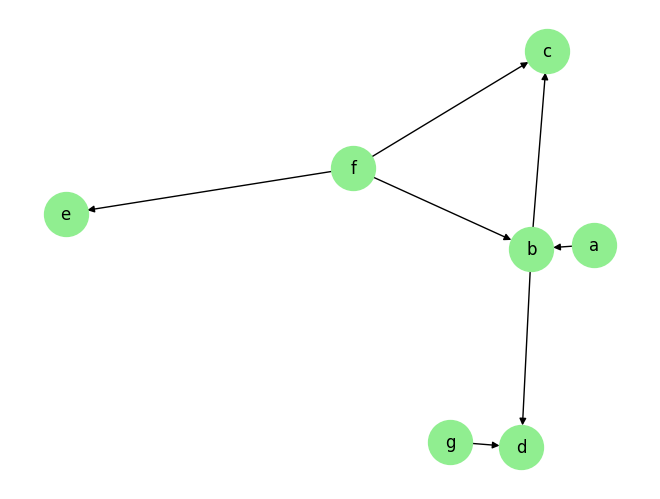
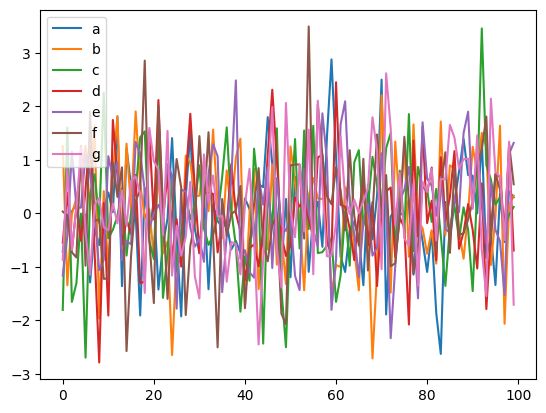
Markov Blanket (MB) Discovery
Enable/Disable Multi-Processing:
When we instantiate our MB discovery model, we need to decide if we want to use multi-processing. Multi-processing typically provides a significant speed-up for the PC algorithm. In order to use multi-processing in our causal discovery library, we pass the argument use_multiprocessing=True to the model constructor. It’s default value is False.
MB Discovery for continuous data
[6]:
prior_knowledge = None # PriorKnowledge(forbidden_links={'a': ['b']})
pvalue_thres = 0.01
CI_test = PartialCorrelation()
# CI_test = KCI(chunk_size=100) # use if the causal relationship is expected to be non-linear
gs = GrowShrink(
data=data_obj,
prior_knowledge=prior_knowledge,
CI_test=CI_test,
use_multiprocessing=False,
update_shrink=False
)
target_var = 'b'
[7]:
tic = time.time()
result = gs.run(target_var=target_var, pvalue_thres=pvalue_thres)
toc = time.time()
print(f'Time taken: {toc-tic:.2f}s\n')
print(f" target var {target_var}\'s estimated MB is: {result['markov_blanket']}")
ground_truth_mb = compute_markov_blanket(causalai2networkx(graph_gt), target_var)
print(f" target var {target_var}\'s true MB is: {ground_truth_mb}")
precision, recall, f1_score = _get_precision_recall_single(result['markov_blanket'], ground_truth_mb)
print(f'Precision {precision:.2f}, Recall: {recall:.2f}, F1 score: {f1_score:.2f}')
Time taken: 0.03s
target var b's estimated MB is: ['f', 'd', 'a', 'c']
target var b's true MB is: {'f', 'd', 'g', 'a', 'c'}
Precision 1.00, Recall: 0.80, F1 score: 0.89
The output result is a dictionary contains the estimated MB under result['markov blanket']. Under result['value_dict'] and result['pvalue_dict'], it contains a dictionary of link strengths between target_var and each each other variable, and a dictionary of the p-value of said strengths respectively. Under result['full_record_values'] and result['full_record_pvalues'], it contains the full history of raw/pvalue of CI tests performed in their order of performance ('value_dict' and 'pvalue_dict' will contain the result of the last such CI test for each variable).
MB Discovery for Discrete Data
[8]:
fn = lambda x:x
coef = 0.1
sem = {
'a': [],
'b': [('a', coef, fn), ('f', coef, fn)],
'c': [('b', coef, fn), ('f', coef, fn)],
'd': [('b', coef, fn), ('g', coef, fn)],
'e': [('f', coef, fn)],
'f': [],
'g': [],
}
T = 5000
data_array, var_names, graph_gt = DataGenerator(sem, T=T, seed=0, discrete=True)
plot_graph(graph_gt, node_size=200)
graph_gt
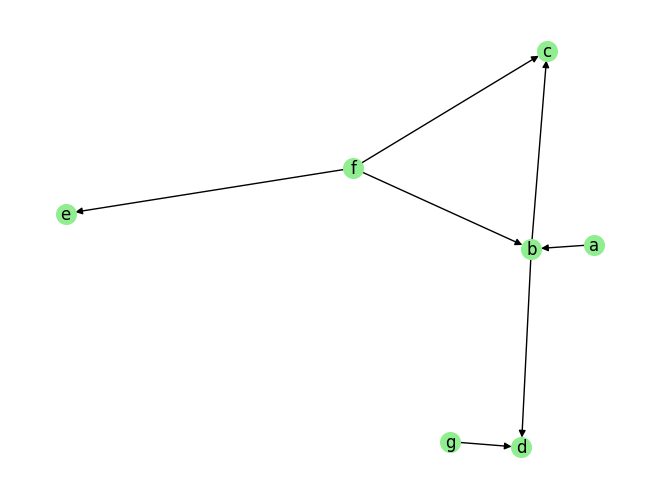
[8]:
{'a': [],
'b': ['a', 'f'],
'c': ['b', 'f'],
'd': ['b', 'g'],
'e': ['f'],
'f': [],
'g': []}
[9]:
data_obj = TabularData(data_array, var_names=var_names)
[10]:
for i, n in enumerate(var_names):
plt.plot(data_array[-100:,i], '.', label=n)
plt.legend()
plt.legend()
plt.show()
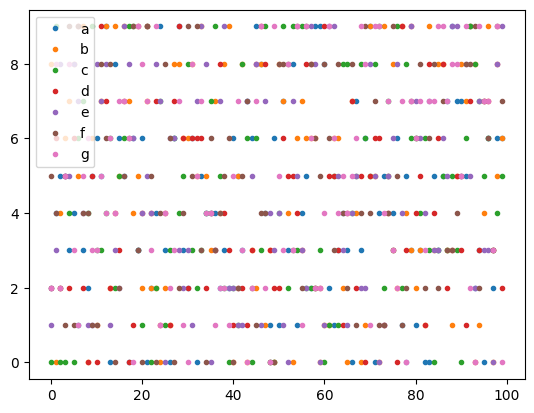
[11]:
prior_knowledge =None# PriorKnowledge(forbidden_links={'c': ['e']}) # g cannot be a parent of c
pvalue_thres = 0.05
CI_test = DiscreteCI_tests(method="pearson")
gs = GrowShrink(
data=data_obj,
prior_knowledge=prior_knowledge,
CI_test=CI_test,
use_multiprocessing=False,
update_shrink=False
)
target_var = 'c'
tic = time.time()
result = gs.run(target_var=target_var, pvalue_thres=pvalue_thres)
toc = time.time()
print(f'Time taken: {toc-tic:.2f}s\n')
Time taken: 0.94s
[12]:
print(f" target var {target_var}\'s estimated MB is: {result['markov_blanket']}")
ground_truth_mb = compute_markov_blanket(causalai2networkx(graph_gt), target_var)
print(f" target var {target_var}\'s true MB is: {ground_truth_mb}")
precision, recall, f1_score = _get_precision_recall_single(result['markov_blanket'], ground_truth_mb)
print(f'Precision {precision:.2f}, Recall: {recall:.2f}, F1 score: {f1_score:.2f}')
target var c's estimated MB is: ['f', 'b', 'e']
target var c's true MB is: {'f', 'b'}
Precision 0.67, Recall: 1.00, F1 score: 0.80
Prior Knowledge Usage
[13]:
# recreating continuous data from earlier
fn = lambda x:x
coef = 0.1
sem = {
'a': [],
'b': [('a', coef, fn), ('f', coef, fn)],
'c': [('b', coef, fn), ('f', coef, fn)],
'd': [('b', coef, fn), ('g', coef, fn)],
'e': [('f', coef, fn)],
'f': [],
'g': [],
}
T = 5000
# var_names = [str(i) for i in range(5)]
# sem = GenerateRandomTabularSEM(var_names=var_names, max_num_parents=2, seed=1)
data_array, var_names, graph_gt = DataGenerator(sem, T=T, seed=0, discrete=False)
StandardizeTransform_ = StandardizeTransform()
StandardizeTransform_.fit(data_array)
data_trans = StandardizeTransform_.transform(data_array)
data_obj = TabularData(data_trans, var_names=var_names)
plot_graph(graph_gt, node_size=1000)
for i, n in enumerate(var_names):
plt.plot(data_trans[-100:,i], label=n)
plt.legend()
plt.legend()
plt.show()
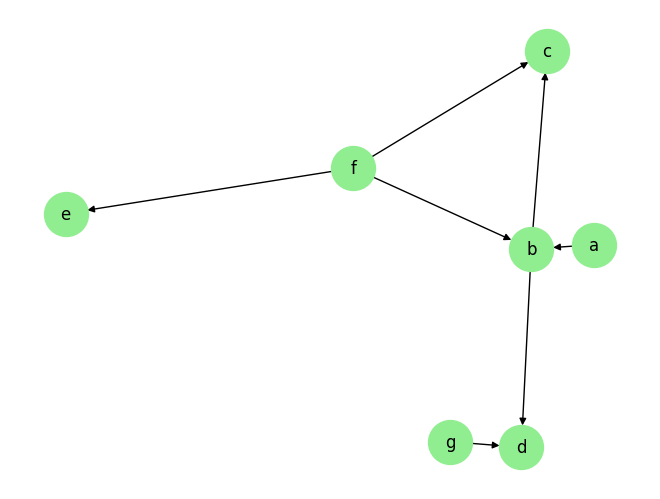
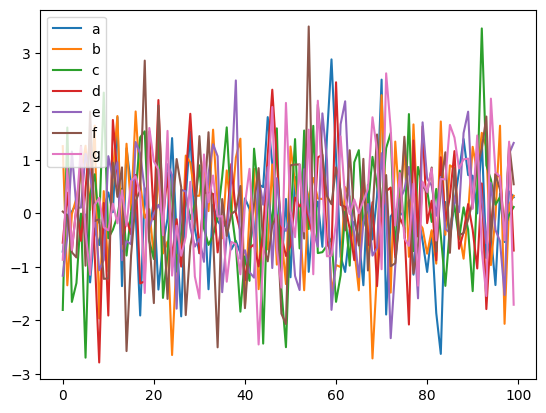
Prior Knowledge: specifying inclusion in MB. This can be done by specifying existing_co_parents or existing_links (or both). Note that without prior knowledge, the algorithm misses a in f’s MB, but with prior knowledge that mistake is corrected.
[14]:
### without Prior knowledge
prior_knowledge = None
pvalue_thres = 0.01
CI_test = PartialCorrelation()
gs = GrowShrink(
data=data_obj,
prior_knowledge=prior_knowledge,
CI_test=CI_test,
use_multiprocessing=False,
update_shrink=False
)
target_var = 'f'
tic = time.time()
result = gs.run(target_var=target_var, pvalue_thres=pvalue_thres)
toc = time.time()
print(f'Time taken without prior knowledge: {toc-tic:.2f}s\n')
print(f"target var {target_var}\'s estimated MB without prior knowledge is: {result['markov_blanket']}")
ground_truth_mb = compute_markov_blanket(causalai2networkx(graph_gt), target_var)
print(f"target var {target_var}\'s true MB is: {ground_truth_mb}")
precision, recall, f1_score = _get_precision_recall_single(result['markov_blanket'], ground_truth_mb)
print(f'Precision {precision:.2f}, Recall: {recall:.2f}, F1 score: {f1_score:.2f}\n')
### with Prior knowledge
prior_knowledge = PriorKnowledge(existing_co_parents={'f': ['a']})
gs = GrowShrink(
data=data_obj,
prior_knowledge=prior_knowledge,
CI_test=CI_test,
use_multiprocessing=False,
update_shrink=False
)
tic = time.time()
result = gs.run(target_var=target_var, pvalue_thres=pvalue_thres)
toc = time.time()
print(f'Time taken with prior knowledge: {toc-tic:.2f}s\n')
print(f"target var {target_var}\'s estimated MB with prior knowledge is: {result['markov_blanket']}")
precision, recall, f1_score = _get_precision_recall_single(result['markov_blanket'], ground_truth_mb)
print(f'Precision {precision:.2f}, Recall: {recall:.2f}, F1 score: {f1_score:.2f}')
Time taken without prior knowledge: 0.02s
target var f's estimated MB without prior knowledge is: ['b', 'c', 'e']
target var f's true MB is: {'b', 'a', 'c', 'e'}
Precision 1.00, Recall: 0.75, F1 score: 0.86
Time taken with prior knowledge: 0.02s
target var f's estimated MB with prior knowledge is: ['a', 'b', 'c', 'e']
Precision 1.00, Recall: 1.00, F1 score: 1.00
Prior Knowledge: specifying exclusion from MB. This can be done by specifying forbidden_co_parents and forbidden_links: note that PriorKnowledge needs to forbid a variable from being a co-parent, and from being a parent, and from being a child of the target variable to guarantee exclusion from MB (if any of these three are missing, the variable would be considered as a valid candidate for inclusion in the MB).
Note that without prior knowledge, the algorithm includes c and d in a’s MB, but with prior knowledge that mistake is corrected. The large pvalue_thres chosen is merely for demonstration purposes.
[111]:
### without Prior knowledge
prior_knowledge = None
pvalue_thres = 0.2
CI_test = PartialCorrelation()
gs = GrowShrink(
data=data_obj,
prior_knowledge=prior_knowledge,
CI_test=CI_test,
use_multiprocessing=False,
update_shrink=False
)
target_var = 'a'
tic = time.time()
result = gs.run(target_var=target_var, pvalue_thres=pvalue_thres)
toc = time.time()
print(f'Time taken without prior knowledge: {toc-tic:.2f}s\n')
print(f"target var {target_var}\'s estimated MB without prior knowledge is: {result['markov_blanket']}")
ground_truth_mb = compute_markov_blanket(causalai2networkx(graph_gt), target_var)
print(f"target var {target_var}\'s true MB is: {ground_truth_mb}")
precision, recall, f1_score = _get_precision_recall_single(result['markov_blanket'], ground_truth_mb)
print(f'Precision {precision:.2f}, Recall: {recall:.2f}, F1 score: {f1_score:.2f}\n')
### with Prior knowledge
prior_knowledge = PriorKnowledge(forbidden_co_parents={'a': ['c','d']},
forbidden_links={'a': ['c','d'], 'c': ['a'], 'd': ['a']})
gs = GrowShrink(
data=data_obj,
prior_knowledge=prior_knowledge,
CI_test=CI_test,
use_multiprocessing=False,
update_shrink=False
)
tic = time.time()
result = gs.run(target_var=target_var, pvalue_thres=pvalue_thres)
toc = time.time()
print(f'Time taken with prior knowledge: {toc-tic:.2f}s\n')
print(f"target var {target_var}\'s estimated MB with prior knowledge is: {result['markov_blanket']}")
precision, recall, f1_score = _get_precision_recall_single(result['markov_blanket'], ground_truth_mb)
print(f'Precision {precision:.2f}, Recall: {recall:.2f}, F1 score: {f1_score:.2f}')
Time taken without prior knowledge: 0.05s
target var a's estimated MB without prior knowledge is: ['c', 'b', 'd', 'f']
target var a's true MB is: {'b', 'f'}
Precision 0.50, Recall: 1.00, F1 score: 0.67
Time taken with prior knowledge: 0.02s
target var a's estimated MB with prior knowledge is: ['b', 'f']
Precision 1.00, Recall: 1.00, F1 score: 1.00
It should be noted that GrowShrink considers prior knowledge ex-ante rather than ex-post. In other words, the algorithm takes the prior knowledge into consideration in its decision making process, rather than just apply it to the predicted MB after the fact. Therefore, given an imperfect CI test, it is possible for correct prior knowledge to cause the algorithm to make mistakes it would not have made without the prior knowledge. Nevertheless, our recommendation is to include all correct prior knowledge as input.